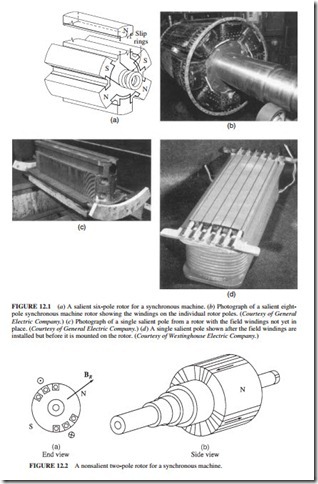SYNCHRONOUS GENERATOR CONSTRUCTION
A direct current is applied to the rotor winding of a synchronous generator to produce the rotor magnetic field. A prime mover causes the generator rotor to rotate the magnetic field in the machine. A three-phase set of voltages is induced in the stator windings by the rotating magnetic field.
The rotor is a large electromagnet. Its magnetic poles can be salient (protruding or stick- ing out from the surface of the rotor), as shown in Fig. 12.1 or nonsalient (flush with the surface of the rotor), as shown in Fig. 12.2. Two- and four-pole rotors have normally non- salient poles, while rotors with more than four poles have salient-pole rotors.
Small generator rotors are constructed of thin laminations to reduce eddy current losses, while large rotors are not constructed from laminations due to the high mechanical stresses encountered during operation.
The field circuit of the rotor is supplied by a direct current. The common methods used to supply the dc power are
1. By means of slip rings and brushes
2. By a special dc power source mounted directly on the shaft of the rotor
Slip rings are metal rings that encircle the rotor shaft but are insulated from it. Each of the two slip rings on the shaft is connected to one end of the dc rotor winding, and a number of brushes ride on each slip ring.
The positive end of the dc voltage source is connected to one slip ring, and the negative to the second. This ensures that the same dc voltage is applied to the field windings regard- less of the angular position or speed of the rotor.
Slip rings and brushes require high maintenance because the brushes must be checked for wear regularly. Also, the voltage drop across the brushes can be the cause of large power losses when the field currents are high.
Despite these problems, all small generators use slip rings and brushes because all other methods used for supplying dc field power are more expensive.
Large generators use brushless exciters for supplying dc field power to the rotor. They consist of a small ac generator having its field circuit mounted on the stator and its armature circuit mounted on the rotor shaft.
The exciter generator output (three-phase ac) is converted to dc power by a three-phase rectifier circuit also mounted on the rotor. The dc power is fed to the main field circuit. The field current for the main generator can be controlled by the small dc field power of the exciter generator, which is located on the stator (Figs. 12.3 and 12.4). A brushless excita- tion system requires much less maintenance than slip rings and brushes because there is no mechanical contact between the rotor and the stator.
The generator excitation system can be made completely independent of any external power sources by using a small pilot exciter. It consists of a small ac generator with per- manent magnets mounted on the rotor shaft and a three-phase winding on the stator.
The pilot exciter produces the power required by the field circuit of the exciter, which is used to control the field circuit of the main generator. When a pilot exciter is used, the generator can operate without any external electric power (Fig. 12.5).
Most synchronous generators that have brushless exciters also use slip rings and brushes as an auxiliary source of field dc power in emergencies. Figure 12.6 illustrates a cutaway of a complete large synchronous generator having a salient-pole rotor with eight poles, and a brushless exciter.
